Risk of melanoma of the skin by age and over time
Cancer data commentary 2
This commentary discusses risk trends for melanoma of the skin at different ages and over time. It supports the introduction of the expanded risk data available in the Cancer data in Australia report.
Some key terms
- For convenience, melanoma of the skin has been abbreviated to ‘melanoma’; please note melanoma may occur in other sites of the body.
- Melanoma incidence risk’ is the risk of being diagnosed with melanoma while ‘melanoma mortality risk’ is the risk of dying from melanoma. This paper uses a risk method that adjusts for competing mortality; Cancer data commentary no.1 provides help in understanding cancer risk methods and concepts.
Melanoma risk
Cancer awareness campaigns such as the 'Slip-Slop-Slap’ campaign of the 1980s and ensuing advertisements since have increased public awareness of melanoma and its prevention. Through continuing education, today’s population should be better informed about how to identify and prevent melanoma than populations of the past.
Lifetime melanoma incidence risk informs risk of being diagnosed with melanoma for the total population (that is, the risk across all ages of the population). Within the total population, older people have lived most of their lives in a less ‘sun smart’ environment while younger Australians have lived the majority of their life in times when public awareness was greater. The following melanoma incidence risk by age commentary highlights the falling risk for the younger populations of today and increasing risk for older populations.
The risk of being diagnosed with melanoma of the skin by the age of 30 has more than halved in 23 years
In 1982, the risk of being diagnosed with melanoma by the age of 30 was around 1 in 600 people. Incidence risk trended upwards and in 1997 has risen to around 1 in 430 people (Figure 1).
From 1997, the risk of melanoma by the age of 30 began to fall. Based on current projections, in 2020 the risk of being diagnosed with melanoma by the age of 30 (estimated at around 1 in 1,170 people) has fallen to less than half of the risk in 1997 (Figure 1).
Following years of consistent decline, the risk of death from melanoma by the age of 30 in 2020 is estimated to be less than one-sixth of the risk in 1982 (1 in 62,000 persons in 2020 compared with 1 in 9,100 persons in 1982) (Figure 1).
Figure 1: Incidence and mortality risk by the age of 30, melanoma of the skin, persons
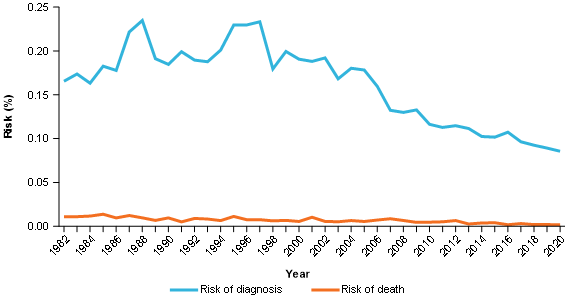
Note: Incidence risk for 2017–2020 and mortality risk for 2019 – 2020 are based on projections.
Source: AIHW Australian Cancer Database 2016 and National Mortality Database
The risk of being diagnosed with melanoma of the skin by the age of 60 peaked in the 1990’s
In 2005, and following years of increasing risk from 1982, melanoma incidence risk by the age of 60 began to fall and then stabilise from around 2012 (1 in 56 people in 2005 to an estimated 1 in 65 people in 2020) (Figure 2).
The large difference between the incidence risk and mortality risk reflects the relatively high survival rates for melanoma when considered in the context of other cancers..
The risk of death from melanoma by the age of 60 decreased consistently from 1982; from 2013 melanoma mortality risk decreased more sharply (from 1 in 650 in 1982 to 1 in 850 in 2013 and an estimated 1 in 1,600 in 2020) (Figure 2).
Figure 2: Incidence and mortality risk by the age of 60, melanoma of the skin, persons
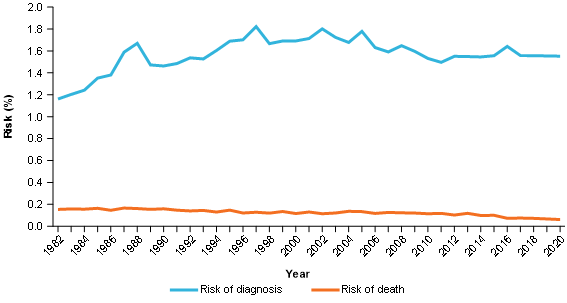
Note: Incidence risk for 2017–2020 and mortality risk for 2019 – 2020 are based on projections.
Source: AIHW Australian Cancer Database 2016 and National Mortality Database
The risk of death from melanoma of the skin peaked in 2013
The lifetime risk of being diagnosed with melanoma is estimated to have tripled since 1982 (1 in 46 people in 1982 to an estimated 1 in 15 people in 2020) (Figure 3). Considering the younger population’s melanoma of the skin incidence risk has been decreasing and incidence risk by the age of 60 has been stabilising, the continuation of increasing melanoma incidence risk is driven by risks from the older population.
Part of the increase in the total population’s risk of being diagnosed with melanoma is due to increasing life expectancy. Essentially, the ageing population increases the proportion of people living to ages for which melanoma is generally more common (Figure 3).
The lifetime risk of death from melanoma continued to rise up until 2013 (Figure 3). Please note that lifetime risk is not the risk for the 'average lifetime', it includes all people within the population and in very broad terms may be considered as risk by age 100 and more.
Figure 3: Lifetime incidence and mortality risk, melanoma of the skin, persons
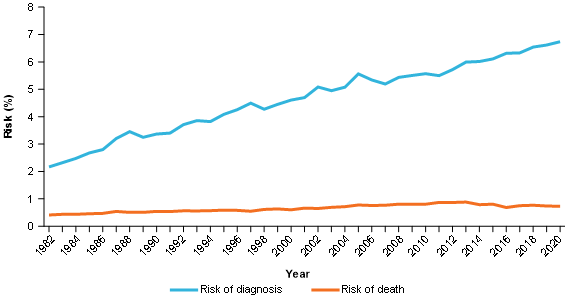
Note: Incidence risk for 2017–2020 and mortality risk for 2019 – 2020 are based on projections.
Source: AIHW Australian Cancer Database 2016 and National Mortality Database
In 2013, the total population’s risk of death from melanoma was around 1 in 110 people; the lifetime melanoma mortality risk in 2013 had more than doubled from 1982 (1 in 240 people). Since the 2013 peak, lifetime melanoma mortality risk is estimated to have fallen to 1 in 140 people (Figure 4). Sharply decreasing mortality risk in conjunction with increasing incidence risk is indicative of improving survival outcomes for those diagnosed with melanoma (Figure 4).
Figure 4: Lifetime mortality risk, melanoma of the skin, persons
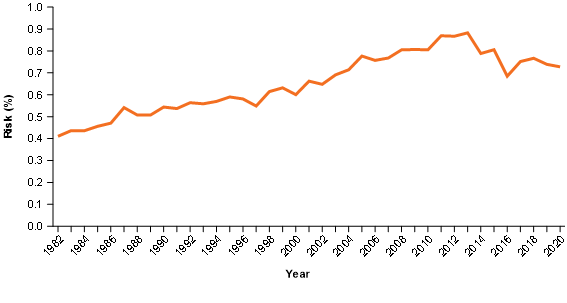
Note: Mortality risk for 2019 – 2020 are based on projections.
Source: National Mortality Database
The lifetime risk of death for males from melanoma of the skin has fallen strongly
The decrease in lifetime mortality risk from 2013 is driven largely by reductions in the comparatively high risk for males (1 in 80 in 2013 to an estimated 1 in 104 in 2020). For females, the lifetime risk of death also fell but at a slower rate (1 in 185 in 2013 to an estimated 1 in 197 in 2020 (Figure 5).
Figure 5: Lifetime mortality risk, melanoma of the skin, by sex, 1982–2020
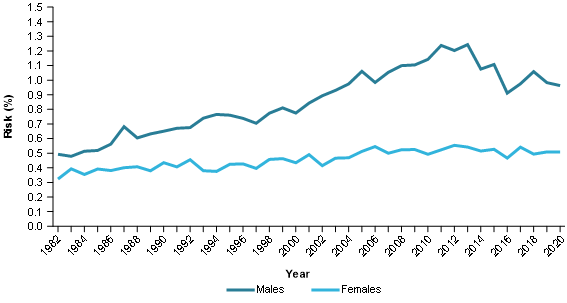
Note: Mortality risk for 2019 – 2020 are based on projections.
Source: National Mortality Database
For both sexes, the lifetime risk of being diagnosed with melanoma continues to increase (figure 6) but the lifetime mortality risk for melanoma is starting to decrease.
Figure 6: Lifetime incidence risk, melanoma of the skin, by sex, 1982–2020
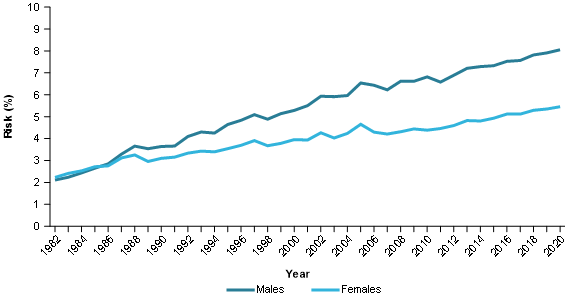
Note: Incidence risk for 2017–2020 are based on projections.
Source: AIHW Australian Cancer Database 2016
While melanoma mortality risk peaked in 2013, impacts of an ageing population (that is, more people living to ages where melanoma incidence rates are higher) will continue to place upwards pressure on the risk of being diagnosed with melanoma and in turn the risk of death from melanoma; this may be particularly true for the ageing populations living in times when ‘Sunsmart’ awareness was less.
Information about the risk data, terms used and where to find melanoma data
About the risk data
- This paper uses a risk method that adjusts for competing mortality; Cancer data commentary no.1 provides help in understanding cancer risk methods and concepts.
- Risk within this paper outlines the risk within the Australian population; an individual’s risk may be different depending on their own risk factors (for example, a daily smoker may have a higher risk of developing types of cancer where smoking is a risk factor).
- Cancer incidence risk in 2017–2020 and cancer mortality risk in 2019–2020 are projections; actual data informs other years.
Terms used
Lifetime risk refers to the risk of (being diagnosed with or dying from) melanoma of the skin for the total population. Lifetime risk is not the risk of the ‘average lifetime’; it is risk by age 100 and greater (to the oldest person/s in the population for the year).
Melanoma incidence risk refers to the risk of being diagnosed with melanoma of the skin.
Melanoma mortality risk refers to the risk of dying from melanoma of the skin.
Where to find melanoma of the skin data
Melanoma data used in the commentary
Data used to inform this commentary is available in these Excel workbooks:
Data tables: Cancer data in Australia commentary no. 2 - Risk of melanoma of the skin by age and over time (XLSX 145kB).
Cancer data in Australia is updated and revised annually. The data used to inform this commentary is consistent with Cancer data in Australia as of 30 October 2020. Following future updates to Cancer data in Australia, the data within this commentary will differ from future Cancer data in Australia reports to some extent.


